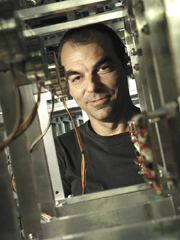
 |

|
|
 |
|
|
|||
 Bill Vorn, aka new media professor Yves Bilodeau. Photo by Christian Fleury |
by James Martin “It’s the only room like this in the school,” says Bill Vorn with dry understatement. The assistant professor of new media (known as Yves Bilodeau in academic circles, Bill Vorn to the art world) sits at a large table covered with Powerbooks and soldering irons, amidst a basement jumble of pneumatic compressors and drill presses. Welcome to the Interactivity Studio in Electronic Arts “project lab.” The fall semester is fresh enough that Vorn’s summer projects have yet to be displaced by student work. Half the room is dedicated to an audio-visual installation called Evil/Live, several massive metal matrices lined with 50-watt light bulbs. On the other side of the table sit the motors and mirrors which will become the robotic-video project Stèle 01, but Vorn’s most ambitious work-in-progress, Bedlam, is nowhere to be seen. When completed, Bedlam will pull off the neat trick of simultaneously existing in three separate places — but for now, it doesn’t physically exist anywhere. The robotic installation, for which Vorn and collaborator Simon Penny recently received $80,000 from the Daniel Langlois Foundation for Art, Science and Technology, is still in its “virtual” infancy. Completion is two years away. Vorn is understandably stymied when asked for an easy sound-bite description of something so large (and, for the time being, so intangible), but the gist of Bedlam is as follows: There will be two identical rooms (one in Montreal, one in Irvine, California) each containing robotic torsos, robotic legs, and a “virtual head,” all hooked up to a system of sensors. The two rooms will be linked via a high-speed internet connection, creating the project’s third “home,” as it were: the cyber-ether between Quebec and California. Visitors exploring either room will unwittingly trigger sound, motion and light “events” amongst the robotic body parts. However, says Vorn, “the idea is to not have the viewers controlling anything. They will influence what’s happening in the room, but they don’t have any control.” Adding to the, well, bedlam will be the internet connection between the two rooms, meaning visitors to Room A may witness robotic responses to unseen stimuli from Room B. Confusion shall reign. “The viewers will know the robots are communicating with another location,” explains Vorn, “so they’ll try to decipher the reactions and figure out if the reactions are local or remote.” He pauses a beat. “Or maybe they won’t figure it out at all.” To put this strange new project into artistic context, Vorn pops a tape into a nearby VCR. A monitor flickers with images from The Trial, a nightmarish sub-performance within a 1999 multi-media staging of Robert Lepage’s Zulu Time. Quick bursts of cold electric light cut the darkness, allowing brief glimpses of mechanical madness. Twitching humanoid forms bounce in midair, like tortured C3P0s strapped into malfunctioning Jolly Jumpers. Writhing robotic arms strike out with serpentine menace. The air crackles with industrial noise, and a freaky time is had by all. Some of Vorn’s work, like The Trial, is meant only to be observed. Others invite brave visitors to tiptoe through the pneumatic actuators. Either way, the atmosphere is always as heavy as the titles: At the Edge of Chaos, Evil/Live, No Man’s Land. Even the rather pleasant-sounding The Frenchman’s Lake refers to a nuclear test site in Nevada. Sound plays a big part in Vorn’s work. He was a co-founder of Rational Youth (an early-80s synth-pop group heavily influenced by the German electrosounds of Kraftwerk and Tangerine Dream), but admits he’s “more into noise than music right now.” His installations use external input (e.g. viewer movement) to generate their own “soundtrack” cacophonies of industrial clangs and electronic cannon-fire. Sight and sound combine to create Vorn’s post-apocalyptic scrapyards. The results feel like scarier versions of Battlebots, the TV game show in which robot hobbyists engage in futuristic, bloodless bloodsport. Although he admits Battlebots is “sometimes fun,” Vorn is quick to clarify his very different agenda. “What I do doesn’t have a function,” he says. “I make something because I have a visual or aesthetic idea —” here he breaks the sombre mood with a most welcome grin “— not because I want to compete in a robot war.” Vorn keeps a sense of humour about his pitch-black, industrial mayhem aesthetic. His students, he cheerily notes, often comment on his uncompromisingly bleak vision. He admits that working with a collaborator might serve to temper Bedlam somewhat. But only a little bit. If that. “I don’t want to make happy things,” he concludes, laughing. “If you want to see Energizer Rabbits, you can go to a theme park.” |